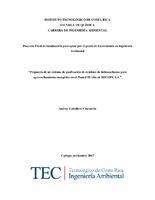Mostrar el registro sencillo del ítem
Propuesta de un sistema de gasificación de residuos de hidrocarburos para aprovechamiento energético en el Plantel El Alto de RECOPE S.A.
| dc.contributor.author | Caballero-Chavarría, Andrey | |
| dc.date.accessioned | 2018-02-08T16:15:01Z | |
| dc.date.available | 2018-02-08T16:15:01Z | |
| dc.date.issued | 2017 | |
| dc.identifier.uri | https://hdl.handle.net/2238/9361 | |
| dc.description | Proyecto de Graduación (Licenciatura en Ingeniería Ambiental) Instituto Tecnológico de Costa Rica, Escuela de Química, 2017. | es |
| dc.description.abstract | Gasification is an important process for the conversion of solid waste materials into useful gaseous products for direct firing in thermal applications and as well as raw gas for production of electricity, fuels or chemicals. The process is influenced by the characteristics of the system where the thermal conversion is carried out, the conditions under which it is developed and the substances used, including the fuel material and the gas necessary to carry out the gasification. In this case, the products could have different components, including mixtures of CO and H2 or syngas, CH4, among others. Among the resources that can be used for gasification are the residues of hydrocarbons and biomass, raw materials that have a significant energy value and are available because they are generated as waste in certain production processes. In addition, its use makes it possible to avoid having to treat and dispose of these residues, minimizing the effect they can have on the environment, while presenting an economic saving. With the objective of taking advantage of the hydrocarbon residues generated as slops in the RECOPE SA fuel distribution plant, located in El Alto de Ochomogo, a gasification system was proposed to obtain electricity, from a mixture of slops and biomass. The selected process was simulated with the Aspen Hysys computational program, in which the gasification reactor is based on an equilibrium multi-phase system in which the lowest Gibbs free energy state is found. The model used the following operating conditions: 22 kg/h of feed flow, 20 kg/h of air as a gasification agent, 1 atm absolute pressure, gasification temperature of 900-1000 ° C and the air / fuel ratio of 0.25, resulting in a syngas of the following percentage composition: 27.44% of H2, 39.79% of CO and 5.73% of CH4, in addition, the energy power of the system is 27.82 kW. On the other hand, an economic analysis was carried out associated with the implementation of the project, in which an initial investment of ₡ 29 400 768 that considers the purchase of a gasification system of fixed bed downdraft. For this analysis, a NPV was obtained considering 10 years later in the range of ₡ 57,027.07 to ₡ 24,032,755.99, and an IRR of 12-30%. The period of recovery of the investment is between 38 to 58 months. | es |
| dc.description.sponsorship | Plantel El Alto de RECOPE S.A. | es |
| dc.language.iso | spa | es |
| dc.publisher | Instituto Tecnológico de Costa Rica | es |
| dc.subject | Biomasa | es |
| dc.subject | Simulación | es |
| dc.subject | Fiananzas | es |
| dc.subject | Gasificación | es |
| dc.subject | Hidrocarburos | es |
| dc.subject | Combustibles | es |
| dc.subject | Electricidad | es |
| dc.subject | Research Subject Categories::NATURAL SCIENCES::Chemistry::Environmental chemistry | es |
| dc.title | Propuesta de un sistema de gasificación de residuos de hidrocarburos para aprovechamiento energético en el Plantel El Alto de RECOPE S.A. | es |
| dc.type | licentiateThesis | es |


